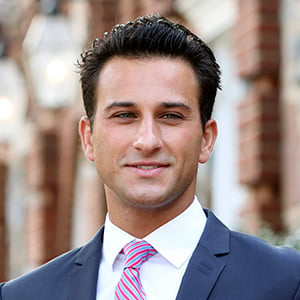In music, a motif is a short, recurring musical idea. It’s a sequence of notes or rhythm, distinct enough to help build the structure and identity of a piece but simple enough to be developed and expounded upon throughout a composition. It’s frequently repeated and used to create unity and meaning.
Most of us are familiar with Beethoven’s Fifth Symphony, for example, and its famous four-note motif (“da-da-da-dum”), which crops up throughout the composition.
Motifs exist outside of music, too. Our personalities, behaviors, past experiences, and dreams for the future can become motifs that we structure our lives around.
These patterns can change and take on different forms of expression, often in unexpected ways. They shift, they morph, transforming a catchy tune into a masterpiece.
My motif started when I was two-and-a-half years old. That’s the first time I picked up the bow to play a cello. By the time I was four, I performed at Carnegie Hall. It’s my earliest memory, and undeniable proof that no matter how old—or young—you are, you don’t forget your first concert at Carnegie Hall.
When I was in elementary school, I was already deep into music. Half of my day was devoted to conservatory-level training. In my teens, I started playing the double bass, developed a passion for jazz, and eventually split my time between the music programs at LaGuardia High School and Juilliard Pre-College.
Growing up in New York City, I was surrounded by some of the most talented artists and musicians in the world. I was graced with some of the most unique opportunities to match.

When I was in high school, I played the national anthem at the Federal Reserve with my brother, who is also a musician. The next day, I emailed every major sporting event marketing team I could find, attaching a video of the performance. Our guerrilla marketing paid off, and we built relationships with the New York Knicks, the Los Angeles Clippers, and other sports teams and venues. Without knowing it at the time, that mentality of looking for new opportunities would reward me later in life.
I studied under the principal bassist in the New York Philharmonic and, when I went to UCLA for my bachelor’s degree, under the principal bassist in the Los Angeles Philharmonic. After finishing my degree at UCLA, I immediately went on to tour Italy with a classical chamber ensemble, following several film score gigs in Hollywood.
Music was the motif that built the structure of my life, framed my personal identity. I believed I was on my way to becoming a professional musician.
Until I wasn’t.
A Key Change
Not long after returning from Italy, prospects started drying up. I thought I was on the path to becoming a gig musician. I had just completed a film score. But I hadn’t built a business plan, and my years of study weren’t panning out how I’d hoped.
Soon enough, my music began reflecting the fear and pressure I was feeling. I had never felt that before and it was something that I never wanted to feel, in my music or otherwise.
My motif changed keys. The pace and melody shifted. I knew it was time for something different, something new.
I was able to draw on my experiences outside of music. After consulting with career counselors at UCLA, I realized I wasn’t just a musician. Landing a gig at Madison Square Garden wasn’t my only brush with building relationships or making the most of the opportunities that came my way. At around 10 years old I had a dog-walking business in the Upper West Side of New York City and early in my career I worked in business development for the publicly traded beverage company, Vita Coco.
I knew what it took to succeed.
And that’s how I went from music to insurance. It was a manifestation of a parallel identity, built around the hustle I’d honed in New York. It helped me land a role at AXA Equitable.
A New Tune
Working in finance was definitely a shift. I wondered if I was giving up on myself, giving up on what I’d been doing since I was a toddler.
But the best pieces of music don’t remain still. They change, they evolve, while still providing that reliable structure. For me, a career in finance — at AXA Equitable and, later, as an independent financial advisor — was a new expression of my motif.
I wasn’t giving up on music, but I was giving up the pressure—pressure I never wanted to feel in the first place. By starting a career in finance, I could let music return to the vocation it had always been for me.
Music is easy to be passionate about, because people love music. But not everyone is passionate about finance, and this new career allowed me to help others identify, explore, and build upon their own motifs.
Helping my clients find and create meaning from their personal motifs, and translating them into their financial lives, is how I connect my background in music to my career in finance. Especially for my clients who do not resonate with the world of Wall Street.
Sometimes I have to identify motifs in client behavior, such as risk tolerance or spending behaviors. In other cases, developing a motif means working towards recurring financial goals, concepts, or deploying strategies around how to invest assets. As an advisor, I can even build longevity into my clients’ motifs.
In the same way that I never wanted fear and pressure to enter into my music, I don’t want to see financial pressure enter into the lives of my clients. If I can turn wealth management into something that supports my clients, rather than intimidates them, I feel like I’ve helped them achieve something real and valuable.
The music never stopped for me; the motif is too central to my life’s symphony. My brother and I continue playing music together, performing in front of thousands of people at Madison Square Garden to watch our beloved Knicks.
But providing my clients with financial advice is even better than inviting them to my stadium-sized gigs. That’s really how I perform for them.
The most inspiring, long-lived musical masterpieces are built and performed one note at a time, by disciplined musicians, who have devoted their life to their craft. In that way, financial advice and music aren’t so different after all.
It’s a tune that sounds pretty good to me.

Concurrent Advisors, its employees, and all third parties listed are not affiliated with TradePMR. No compensation was paid to the author for this article. This article reflects the author's experience. Your experience may vary.

